The Kawasaki Mule is a popular utility vehicle known for its reliability and versatility in various working environments. However, like any mechanical machine, the Mule is not immune to issues, particularly with its transmission system. Transmission problems can arise and often do so after extended use, leading to challenges in gear shifting, sticking gears, and occasional noises during gear changes. Understanding these issues is key to maintaining your Mule’s longevity and performance.
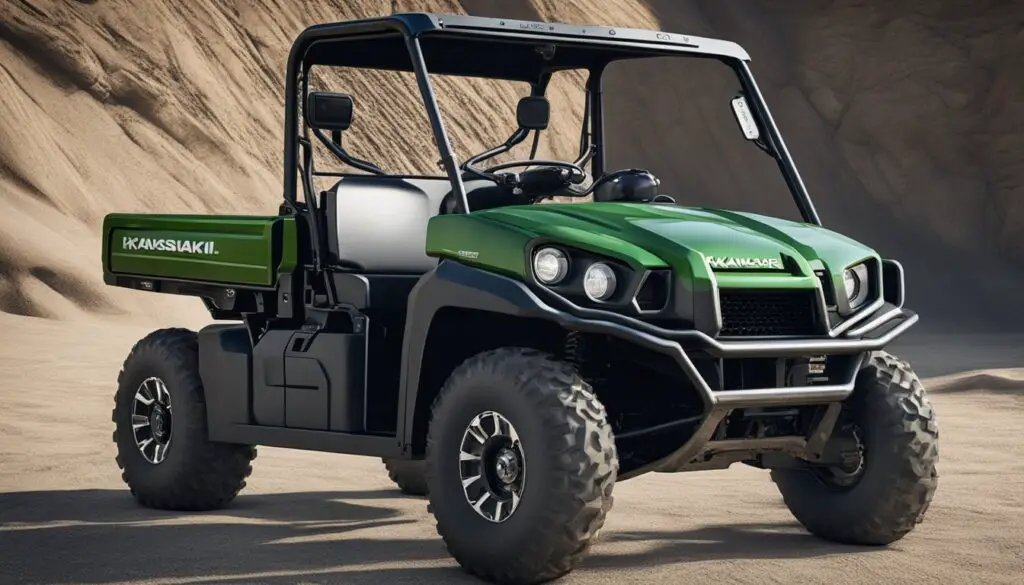
Identifying and addressing transmission problems early can prevent more severe damage and reduce repair costs. Common signs of transmission distress include difficulty in shifting gears, unresponsive gear shifts after stopping, and grinding noises. The causes can range from low fluid levels or worn components to more complex gearbox issues. Regular maintenance and a keen awareness of your Mule’s performance are essential to keep the transmission functioning properly.
Key Takeaways
- Maintaining your Kawasaki Mule’s transmission can help prevent common issues.
- Early detection of transmission symptoms can save on costly repairs.
- Regular servicing is crucial for transmission longevity and vehicle reliability.
Understanding Kawasaki Mule Transmission Basics
Kawasaki Mule UTVs are engineered for durability and performance, but understanding the basic elements of your Mule’s transmission can keep it running smoothly. Let’s explore the crucial mechanical components and the role of transmission fluid. https://www.youtube.com/embed/im1vjmoZgR8
Mechanical Components
Your Kawasaki Mule’s transmission is a complex system comprising various gears and components that work together to transfer the engine’s power to the wheels. Key mechanical components include:
- Gears: These come in different sizes and engage with each other to change the speed and torque from the engine.
- Shafts: They carry rotational force to the UTV’s wheels.
- Clutch: This part engages or disengages the engine from the transmission to shift gears.
- Final Drive: A set of gears that reduce the speed and increase the torque provided to the wheels.
Taking care of these components, through regular maintenance, can help prevent common problems like gear slippage or jerky shifting.
Transmission Fluid Functionality
Transmission fluid in your Kawasaki Mule serves multiple critical functions:
- Lubrication: It reduces friction between moving parts, protecting against wear and overheating.
- Cooling: Transmission fluid dissipates heat away from the gears and clutch.
- Hydraulic Pressure: It assists in gear shifting by creating the necessary pressure within the hydraulic system.
- Cleaning: Fluid carries away metal shavings and contaminants, which are then filtered out to prevent damage.
It’s essential to maintain the proper fluid level and change the fluid according to Kawasaki’s recommended service intervals to avoid transmission problems. Low fluid levels can cause damage to the transmission components and should be addressed immediately to prevent costly repairs.
Common Kawasaki Mule Transmission Issues
Your Kawasaki Mule is a dependable workhorse, but even the most reliable vehicles can stumble upon transmission issues. Whether you’re experiencing difficulty in shifting gears or your Mule’s transmission is slipping, understanding these common problems will help you address them more effectively.
Gear Shift Problems
When you’re having trouble with the gear shift, it can be a frustrating experience. Gear shifting problems in your Kawasaki Mule often manifest as difficulty in changing gears or hearing unusual noises during gear shifts. Ensure your transmission fluid is at the appropriate level as low fluid can be a primary culprit. Worn-out clutches or damaged components may also lead to gear shift issues.
Transmission Slippage
If you’re noticing that your Mule’s transmission is failing to stay in gear or is slipping between gears, your vehicle could be exhibiting transmission slippage. This issue might cause the engine to rev without proper acceleration. It’s essential to inspect for transmission fluid leaks and verify that sensors and wiring are intact and not causing malfunctions.
Identifying Kawasaki Mule Transmission Symptoms
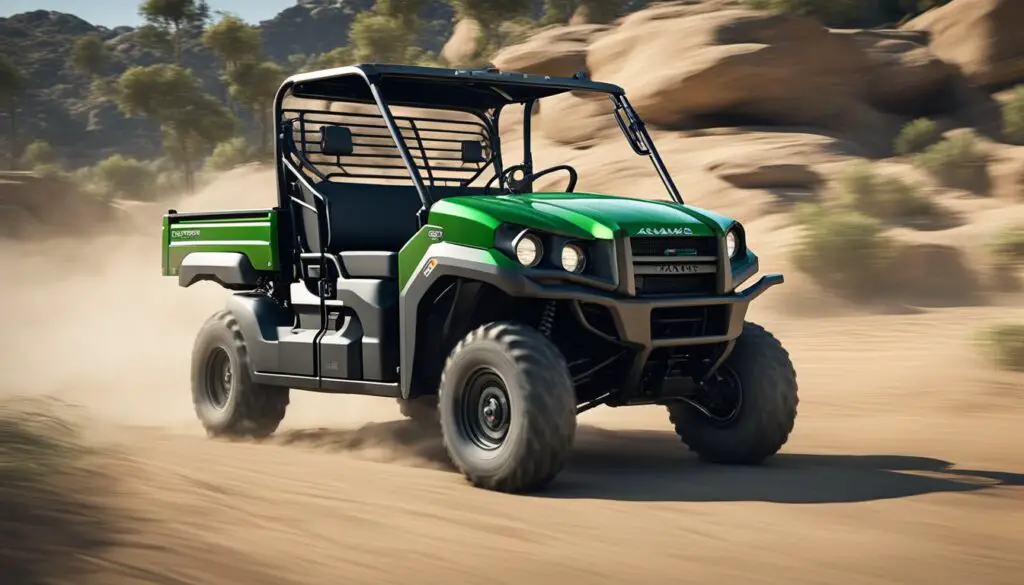
When your Kawasaki Mule starts to exhibit transmission problems, prompt identification is key to preventing more significant issues. Pay close attention to the way your vehicle sounds and how it responds when you change gears.
Unusual Noises
One tell-tale sign of a transmission problem is hearing unusual noises. These could range from a rubbing or squealing sound to grinding noises when shifting gears. A healthy transmission operates smoothly and quietly, so any persistent noise, especially under acceleration, could indicate a misalignment or a problem with the drive belt or clutch components.
Delayed Engagement
Another symptom you might notice is delayed engagement. This means when you shift into drive or reverse, there’s a noticeable delay before the Mule begins to move. When you experience this, the transmission is struggling to engage properly, which could be due to low fluid levels or worn clutch materials. Immediate attention to these issues is crucial to maintaining your vehicle’s performance and safety.
Diagnosing Electrical Concerns
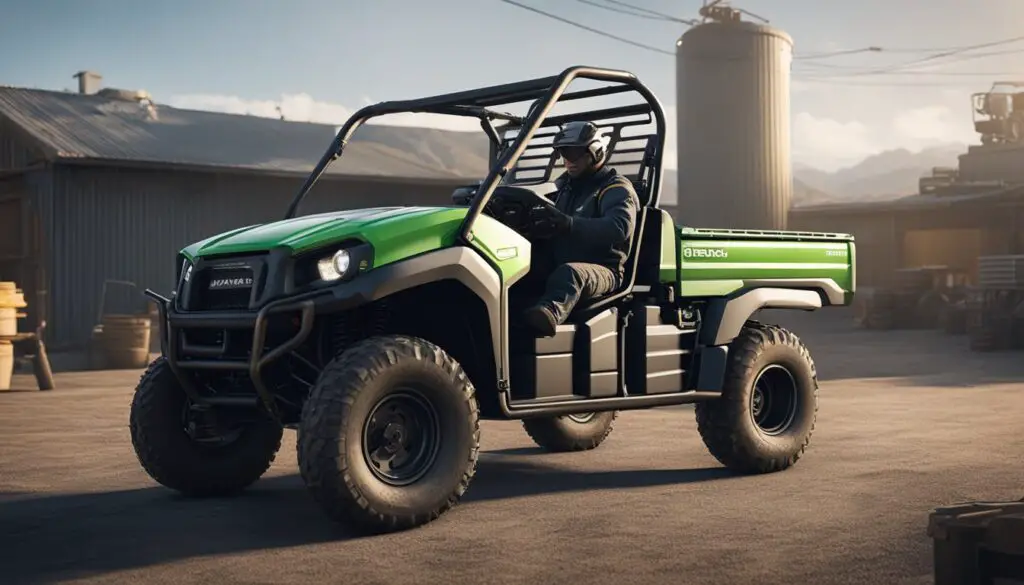
When your Kawasaki Mule starts showing signs of electrical issues, it’s crucial to address them promptly. A well-maintained electrical system ensures reliability and prevents potential power loss. Here is how you can check the most important electrical components.
Battery and Connections
First, inspect your battery terminals for corrosion or loose connections, which could lead to electrical power loss. Ensure that your battery is fully charged, as a dead battery is often a simple yet overlooked problem. Follow these steps:
- Inspect the battery terminals for corrosion; clean them if necessary.
- Check that the terminals are tightened properly to ensure good contact.
- Test the battery voltage with a multimeter; it should typically read around 12.6 volts when fully charged.
Sensors and ECU Related Issues
The Engine Control Unit (ECU) orchestrates the orchestra of sensors; hence, a glitch here can cascade into numerous electrical ailments. Here’s what to look for:
- Throttle Position Sensor (TPS): Erratic behavior can stem from TPS issues. Make sure it is calibrated correctly.
- Wiring Harness Problems: Look for frayed or damaged wiring that could interfere with sensor signals.
- DFI Light: If your Kawasaki Mule’s Digital Fuel Injection (DFI) warning light turns on, it could indicate issues with sensors or the ECU.
Regular checks and maintenance on these elements can prevent many common electrical problems from becoming major headaches.
Fuel System Diagnostics
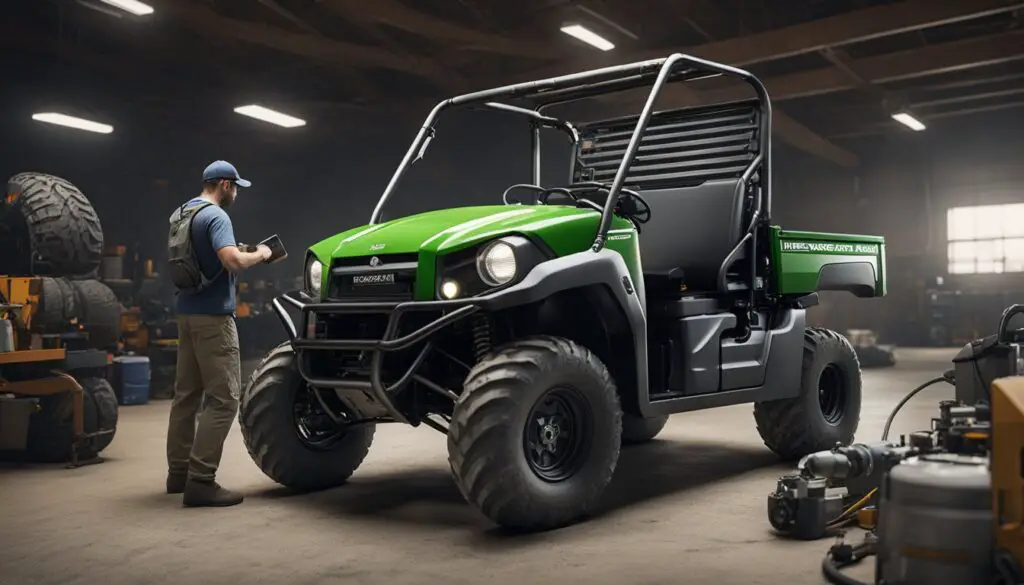
When tackling issues with your Kawasaki Mule’s transmission, it’s crucial to ensure that fuel system components like the fuel pump, filter, and injectors are in good working order, as they can affect the vehicle’s overall performance.
Fuel Pump and Filter Assessment
First, check your fuel pump and fuel filter for signs of wear or damage. A problematic fuel pump can lead to inconsistent fuel flow, which may manifest as changes in the vehicle’s driving performance.
- Fuel Pump: Verify the fuel pump pressure by:
- Disconnecting the fuel line from the fuel rail.
- Placing the end of the fuel line into a measuring container.
- Turning the key to ‘ON’ and observing the fuel flow.
- Fuel Filter: Inspect the fuel filter for clogs by:
- Removing it from the fuel line.
- Examining it for debris or contamination.
- Replacing the filter if any blockage is found.
Maintaining clean fuel lines and ensuring your coolant level is adequate are also vital for an efficiently running fuel system.
Throttle Body and Injectors
Next, assess your throttle body and fuel injectors as they play a critical role in managing the air-fuel mixture.
- Throttle Body: Ensure that the throttle body is:
- Free from obstruction.
- Not malfunctioning.
- Cleaning can be accomplished by:
- Removing any debris.
- Wiping it with a non-abrasive cleaner.
- Fuel Injectors: Confirm that the injectors are:
- Delivering fuel effectively.
- Not clogged by examining for irregular spray patterns or leaks.
- Conduct regular maintenance by:
- Using quality fuel.
- Adding fuel injector cleaner to your system periodically.
Finally, don’t forget to inspect associated components like the air filter, ignition coil, and spark plugs, which can indirectly affect fuel delivery and engine performance.
Performance and Efficiency

When your Kawasaki Mule begins experiencing transmission issues, it’s crucial to understand the performance and efficiency implications. Not only do these problems affect your Mule’s ability to work effectively, they can also lead to a decline in overall engine health.
Overheating and Cooling System
Your Kawasaki Mule’s transmission is prone to heat build-up, especially during heavy use or in high-temperature environments. Heat is a primary enemy of transmission efficiency, potentially causing overheating. Overheating can be a sign of a compromised cooling system. To prevent this:
- Check the coolant levels regularly and refill if necessary.
- Ensure the cooling system is clean, with no blockages that could impede airflow.
- Inspect the radiator and cooling fans for damage or malfunctions.
Engine Power and Acceleration
The transmission is integral to delivering power smoothly from the engine to your wheels. When transmission problems occur, you might notice a significant drop in engine performance and vehicle acceleration. Be aware of these symptoms:
- Difficulty in shifting gears can lead to loss of engine and electrical power.
- A transmission struggling to engage properly may cause idling issues.
By maintaining the transmission in your Mule, you can ensure that it delivers the power your engine is capable of, without a drop-off in performance or speed. Regular checks and maintenance are key to keeping your Mule running smoothly and efficiently.
Preventative Maintenance Strategies
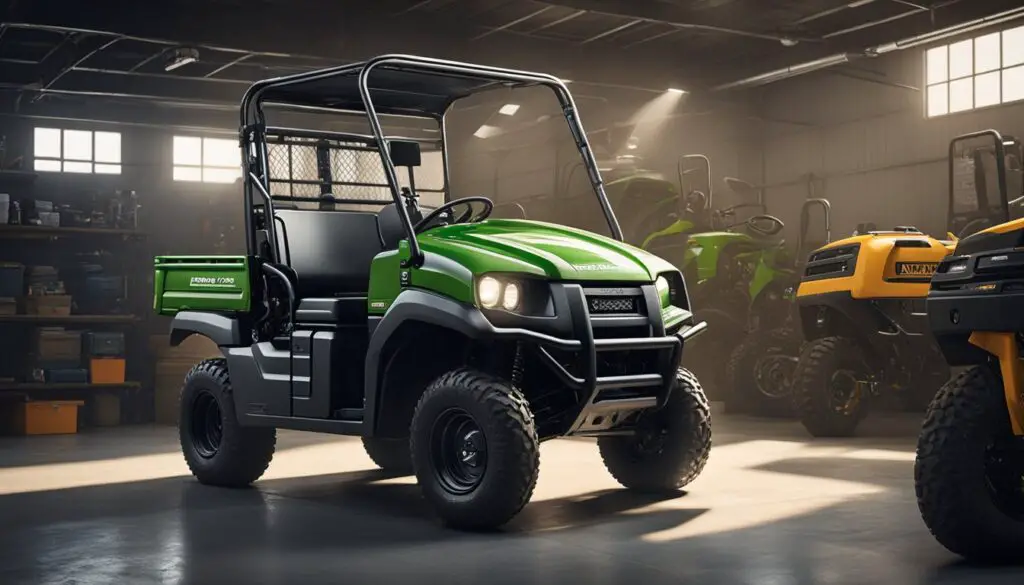
To ensure your Kawasaki Mule’s longevity and performance, staying proactive with maintenance is key. Below are focused strategies to keep transmission troubles at bay.
Regular Check-Ups
Frequent inspections are essential for catching potential issues before they escalate. Make it a habit to:
- Check the belt for signs of wear or damage. A healthy belt is crucial for smooth operation.
- Monitor the transmission fluid level; low levels can lead to significant damage. Ensure it’s at the correct level and topped off if necessary.
Transmission Care
Proper transmission maintenance ensures your Mule is always ready for work. Focus on two main aspects:
- Keep the transmission system clean. Dirt and debris can cause premature wear.
- Maintain coolant levels to prevent overheating and protect the transmission.
- Regularly inspect and maintain the fuel system to ensure optimal performance.
Troubleshooting and Fixes
When you encounter transmission problems with your Kawasaki Mule, effective troubleshooting can often save the day. Whether it’s a simple fluid check or a more involved transmission component repair, getting to the root of the issue is key.
Minor Adjustments
Performing minor adjustments often resolves some of the more common transmission issues. Keep in mind the following:
- Check fluid levels and top up if necessary. Low fluid can lead to damage, so maintain appropriate levels to ensure smooth operation.
- If you’re experiencing a throttle body and sensor problem, sometimes a quick reset can help. Turn the ignition on and off a few times to see if it recalibrates.
- Use spray throttle body cleaner to clean any dirt or grime that might be causing blockages. Make sure the engine is cool before you do this.
Major Repairs and Replacement
If initial fixes don’t resolve the issues, you may be looking at more significant repairs:
- For persistent throttle body issues, removal and thorough cleaning, or in some cases, replacement might be necessary.
- A malfunctioning transmission often requires professional intervention. Don’t hesitate to hand this task over to a qualified mechanic who can handle the intricate work this entails.
- Sometimes, sensors within the transmission system fail and must be replaced to restore functionality. This is a delicate process and should be done with caution.
Kawasaki Mule Model-Specific Issues
In this section, you’ll find specific transmission issues that pertain to the Kawasaki Mule 4010 and the Kawasaki Mule Pro variants. Each subsection targets your model’s particular challenges to help you identify and address them effectively.
Kawasaki Mule 4010
The Kawasaki Mule 4010 commonly experiences transmission problems characterized by difficulties in shifting. Notably, low fluid levels can cause significant damage to transmission components, leading to premature failure. It’s crucial for you to check and maintain proper fluid levels to prevent this issue.
Owners have also reported a tricky shift from Low to High and vice versa; the belt may appear to be in a bind, necessitating a forceful gas pop to facilitate the shift. Additionally, transmission sensor malfunctions could turn on your DFI light, indicating potential transmission-related issues.
Kawasaki Mule Pro Variants
The newer Kawasaki Mule Pro variants, including the Pro FXT, the Pro FXT Ranch Edition, and the Pro MX, may exhibit different transmission issues compared to the 4010 model. For instance, the Pro FXT has been known for transmission noise, while gear shifting difficulty sometimes appears in Pro MX models.
Furthermore, the complexity of the Pro FXT Ranch Edition can mean that transmission problems might stem from electronic issues, such as loose or damaged wiring harness connectors. Each connector could have 18-24 pins that, if they become loose, can lead to a myriad of operational problems, some of which may mimic or directly impact the transmission.
When addressing any transmission issues on your Kawasaki Mule, no matter the model, always start with basic troubleshooting such as checking fluid levels and ensuring that no debris is causing a blockage. Regular maintenance can often prevent the most common issues from becoming major problems.
Handling Warranty and Dealer Support
When your Kawasaki Mule faces transmission issues, understanding your warranty coverage and knowing how to engage dealer repair services is pivotal for a hassle-free experience.
Understanding the Warranty Coverage
Your Kawasaki Mule comes with a manufacturer’s warranty that covers various components of your vehicle, which can include the transmission system. It’s important to review the terms of your warranty carefully to ascertain what is covered and for how long. If a recall has been issued for your model, the repairs related to the recall will be completed by the dealer free of charge.
- Check Documentation: Refer to your owner’s manual or warranty booklet.
- Warranty Duration: Note the coverage time period, often stated in months or miles.
- Warranty Limitations: Be aware of any conditions or maintenance requirements.
Dealer Repair Services
Should you need transmission repairs, your authorized Kawasaki dealer can provide professional service. Dealers are equipped to perform warranty work, and they have the expertise to conduct thorough diagnostics and repairs. If your warranty has expired, you can still authorize a review and repair, but it will be at your expense.
- Contact Dealer: Schedule an appointment with a Kawasaki dealer for diagnostics.
- Diagnostic Report: Review the dealer’s findings and discuss the best course of action.
- Repair Authorization: If out of warranty, approve the necessary repairs.
Remember to keep all records of service visits and repairs, as they could be necessary for any future warranty claims or servicing needs.
Safety and Operational Advice
When operating a Kawasaki Mule, your safety and the Mule’s functionality are directly linked to how you manage the ride and cargo. Pay special attention to the operation of the brakes and the engine, especially when handling loads or navigating on level ground.
Proper Riding Techniques
Your Kawasaki Mule is equipped with features designed to keep you safe, but it’s essential to use proper riding techniques to maximize these benefits. Always use the engine braking system effectively when descending slopes, as relying solely on the standard brakes may not provide optimal control. Ensure you:
- Apply brakes smoothly and gradually to avoid abrupt stops.
- Ascend or descend hills straight up or down, not at an angle, to reduce the risk of tipping.
Transport and Load Management
Managing your load correctly ensures not just the longevity of your Mule’s transmission, but also your safety. Here’s how to maintain an even keel:
- Load Distribution: Distribute the weight evenly, and don’t exceed the recommended load capacity.
- Surface Evaluation: Operate on solid, level ground whenever possible to avoid undue stress on the transmission and potential safety hazards.
By following these guidelines, your rides will not only be safe but will also help in maintaining the normal function of your Mule’s transmission system.
Legal and Compliance Considerations
When owning a Kawasaki Mule, you should be aware of any legal notices such as recalls and compliance certifications that could impact your vehicle’s operation or safety standards.
Recall Information
Recall Notifications: You may receive recall notices if your Kawasaki Mule is identified as having safety-related defects. It’s important to respond promptly to these notices to ensure your vehicle remains safe and operational.
- Current Recalls: Always check the National Highway Traffic Safety Administration (NHTSA) for up-to-date recall information.
- Vehicle Identification Number (VIN): Use your Mule’s VIN to search the database for any recalls specific to your utility vehicle model.
Compliance Certifications
Emission Standards: Your Kawasaki Mule must meet specific emission standards to be used legally on off-road trails. Check for an emission compliance label located on the vehicle to verify that your Mule is compliant with these regulations.
- Certification Labels: Look for labels indicating compliance with safety and environmental regulations. These labels are often found near the driver’s seat or under the hood of the utility vehicle.
By staying informed about recalls and ensuring your Mule meets compliance certifications, you can enjoy your off-road adventures with peace of mind.
Personal Experience and User Reviews
When exploring the reliability of Kawasaki Mule transmissions, your peers’ experiences can be incredibly telling. Users often share detailed accounts of their encounters with shifting problems and other transmission-related issues.
Owner Anecdotes
Users frequently discuss shifting issues in the Kawasaki Mule, specifically relating to the 2020 Mule SX. You might hear about the need to “pop the gas hard” to shift from Low to High or when changing into Neutral or Reverse. It’s common to see that the belt feels in a bind, making shifting difficult without additional throttle input.
A farmer’s review may recount instances where their Mule’s rear end locks up after sitting, which can be especially troublesome during busy workdays. Some owners have found temporarily fixing the issue by shifting into reverse and then back to drive, often accompanied by a rear tire squealing upon acceleration.
Expert Opinions
Experts often weigh in on these transmission woes, confirming that these are not isolated incidents. They might suggest checking the fuel pump pressure as a step toward diagnosing the problem, especially since a faulty fuel pump can exacerbate or mirror transmission issues. Here’s a simple check an owner or a local mechanic can perform:
- STEP 1: Remove the fuel line from the fuel rail.
- STEP 2: Place the fuel line end into a measuring cup.
- STEP 3: Turn the key to ‘ON’ to measure fuel pump output.
Advice you might find common among experts includes ensuring that warranty conditions are clear since transmission repair can be costly and might not always be covered, particularly if improper use is suspected. If you come across terms like DFI Light issues or chattering from the front differential, experts suggest these could be indicators of more widespread problems with the Mule 4010 model.
Final Thoughts and Recommendations
In addressing the transmission issues faced by Kawasaki Mule owners, it’s crucial for you to adhere to maintenance guidelines and understand how different models may vary in terms of reliability and performance.
Best Practices
It is essential to routinely check and maintain your Kawasaki Mule’s transmission. Regular maintenance increases reliability and prevents the common shifting problems that are often reported. Here is a brief list of best practices:
- Check Fluid Levels: Ensure your transmission fluid is at the correct level to avoid damage.
- Inspect Clutch Components: Worn clutch plates or springs could lead to grinding when shifting.
- Listen for Unusual Noises: A sign of potential transmission issues is unusual sounds during operation.
Model Comparisons
When comparing models such as the Mule SX and the Kawasaki Mule Pro FXT, consider their intended use:
- Mule SX: Suitable for light work and narrow trails.
- Kawasaki Mule Pro FXT: Designed for heavier loads and more demanding off-road conditions.
Each model comes with its specific maintenance regimen. Frequenting a certified Kawasaki dealer for service can ensure your utility vehicle remains in top-notch condition for all your off-road adventures.
Frequently Asked Questions
If you’re experiencing issues with your Kawasaki Mule’s transmission, you’re not alone. This section covers some of the most common questions owners have about transmission problems and their solutions.
Why is my Kawasaki Mule not shifting gears smoothly?
It’s possible that your Mule is experiencing shifting issues due to a worn clutch, low transmission fluid levels, or damaged gear synchronizers. These can cause difficulty in gear transition, unexpected noises, or resistance that prevents smooth shifting.
What should I do if my Kawasaki Mule’s transmission is slipping?
Transmission slipping can be a sign of low fluid levels or worn transmission components. Check the fluid level, ensure it’s at the recommended level, and look for signs of leaks. If the problem persists, it might require a professional assessment and repair.
How do I troubleshoot a Kawasaki Mule that won’t go into gear?
First, check for any obstructions that may be blocking the transmission. Make sure that the transmission fluid is at the correct level and that there are no visible signs of damage to the transmission components. If these are all in order, the issue may lie with the gear linkage or internal transmission parts, which could require a professional mechanic’s attention.
Are there any common transmission fluid issues with Kawasaki Mules?
Yes, low fluid levels are a common problem that can cause your Mule’s transmission to malfunction. It’s essential to ensure that your transmission fluid is filled to the recommended level and to check for potential leaks regularly.
What maintenance steps are recommended for the transmission of a Kawasaki Mule?
Regular checks of transmission fluid levels, alongside inspection for leaks and wear, are crucial for maintaining your Mule’s transmission. Consult your owner’s manual for detailed maintenance recommendations and service intervals.
How often should the transmission of a Kawasaki Mule be serviced?
The frequency of transmission service for a Kawasaki Mule varies based on usage and model-specific recommendations. It is typically advised to check the transmission fluid level and quality every time you perform regular maintenance or at least annually. A full transmission service may be recommended every few years, as specified in your vehicle’s service manual.

Leave a Reply